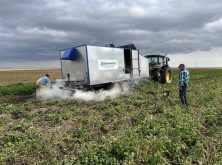Arkansas has been ground zero for herbicide-resistant weeds. For instance, the state is second only to Australia in the amount of herbicide-resistant ryegrass in wheat.
“We’re actually running out of herbicides, making it difficult for us to even grow wheat in Arkansas, because of the levels of resistance that we have,” said Dr. Bob Scott. The state has had a large helping of resistance problems in other crops as well.
Scott shared Arkansas’ herbicide- resistance history with farmers gathered in North Battleford for Cavalier Agrow’s farm forum. Scott, a weed scientist, works in extension through the University of Arkansas.
Read Also

Claas brings 1000 Series SP forage harvesters to Canada
In mid-August, Claas unveiled its new line of Jaguar forage harvesters at an event in Visalia, California, deep in the heart of that state’s dairy region.
By the 1990s, Arkansas farmers were already battling weeds that were immune to DNA herbicides. Farmers were also facing other problem weeds such as ALS-resistant cockleburs.
“In 1999, Roundup came along and rescued us,” said Scott. Farmers rapidly adopted glyphosate, and everything seemed great, he said.
“But what we didn’t know at the time was that we were putting an astronomical amount of selection pressure on Roundup as a herbicide,” he said.
Horseweed was the first to develop glyphosate resistance. Scott said the difference between resistant and susceptible horseweed was like the difference between a Roundup Ready crop and a regular crop.
Horseweed seeds are wind-borne, so resistant plants spread rapidly across the state. Scott said the weed also started emerging later in the spring.
“So we were selecting for a biotype of this weed that was not only resistant to Roundup, but was emerging after the dicamba went out, after the burn-down went out, and coming up in the Roundup Ready crop.”
Other glyphosate-resistant weeds — common and giant ragweed, Johnsongrass — followed. Scott said the state was averaging a new glyphosate-resistant weed every year and a half to two years.
“We were throwing something in the tank. We were adding a burn-down. But we really hadn’t made a lot of wholesale changes in the way we farm,” said Scott.
The first signs of resistance
In 2006, a farmer reported a Palmer pigweed patch that he’d sprayed several times with glyphosate.
“So we came out and sampled some seeds, took them to the greenhouse, and had one of those ‘Oh, crap,’ moments,” said Scott. They’d found their first resistant pigweed population.
Palmer pigweed is a particularly vexing plant to deal with. If the weather cools after the pigweed emerges, it will only grow four or five inches before putting on a seed head, Scott said. But under ideal conditions, it will grow taller than a man. During one study, one pigweed plant produced over 1.8 million seeds, Scott said.
If the weed emerges in a favourable spot, Palmer pigweed will produce plenty of seed and little pollen. The seeds will fall in that spot, Scott explained.
But if the weed is under stress when it comes up, due to the location, it will embrace its masculine side, producing more pollen “so that its genes can be carried off to another spot. Pretty unique evolutionary adaptation for a weed,” said Scott.
Palmer pigweed also readily hybridizes, crossing with other pigweeds and waterhemp, Scott said. “These pigweeds have no morals whatsoever.”
Between 2006 and 2011, glyphosate-resistant Palmer pigweed had spread to most soybean-growing counties in Arkansas. Scott said it spread through pollen, to some extent, but he thinks the main culprit was farm equipment.
Manual weeding
The rise of glyphosate-resistant weeds brought a host of problems to Arkansas farms.
Resistant horseweed pushed farmers to apply more dicamba. The herbicide was applied in every cotton field and many soybean fields, adding considerable production costs, Scott said. Dicamba also has long plant-back intervals, Scott added.
Glyphosate-resistant weeds proved to be a huge problem for cotton growers. The crop has to be grown in wide rows, making weed control very difficult, Scott explained.
“We saw the reintroduction of hoe-crews in fields where we had not seen them ever before,” he said, adding the cost was “unsustainable.”
Scott related the case of one farmer who had a severe pigweed problem. Scott visited the farm when glyphosate-resistant pigweed started popping up in combine passes. He suggested switching to Liberty Link.
But other advisers talked the farmer out of it, Scott said. Instead, they suggested tank mixes for the next crop.
“The herbicides they chose to use to try to stay in Roundup, this pigweed happened to already be resistant to,” said Scott. They applied the mix a couple of times, to no avail. The pigweed overtook the crop. There were field areas where the farmer couldn’t run the combine, and Scott said he lost $230 per acre in those spots.
The next year, Scott ran a demonstration plot in that field, with a residual program. They were able to control the pigweed, said Scott.
Scott said cotton and soybean growers had to change the way they farmed. “Pigweed did not care how that guy wanted to farm. It didn’t care if he wanted to get one more year out of Roundup or not. It forced our hand, big time.”
Farmers are back to using residual herbicides, he said. They also rely on Group 14 chemistry, he added, although Group 14 resistance has been documented in other states.
Lessons learned
Scott read through a list of glyphosate-resistant weeds in Western Canada, noting farmers here have some problems, too. He suggested growers look at herbicide use and production history on their own farms now, even if they don’t have big problems yet.
“Maybe making a simple change now will prevent all of this kind of stuff from happening to you guys up here like it did to us in Arkansas.”
Farmers should pay attention to weeds that survive herbicide applications, Scott said. “Act on them while you can because prevention is a lot better than the cure in some cases.”
Running the combine through a resistant weed patch seeds the entire field for the next year, he added.
Adding a second chemical to glyphosate will only give farmers one mode of action if they already have glyphosate-resistant weeds, Scott said. Farmers should also remember that there’s “no reverse selection pressure” for weed resistance, he said. Weeds will remain resistant in the years to come. Scott has a research plot with pigweed that is resistant to three modes of action. Two were selected for in the ’80s and ’90s, he said.
Scott rarely recommends a single mode of action these days. Even with the Liberty Link system, he suggests residuals to get multiple modes of action. Farmers can get up to four modes of action out of that system, none of which have widespread resistance, he said.
While the Liberty Link system has helped Arkansas farmers, Scott said it’s being abused, too. For example, some people are spraying too late. A 12-day difference in application can mean the difference between 75 per cent and 100 per cent control, he said.
Three or four years of residuals and concerted efforts to cut the seed bank make a big difference when it comes to knocking down pigweed on a farm, he said. Controlling glyphosate-resistant pigweed has forced farmers to manage other resistant weeds, too, and they haven’t been finding new resistant weeds lately, he said.
Scott sees crops that can tolerate several modes of action in the future. He’s had an early look at Monsanto’s Roundup Ready Xtend system, which includes glyphosate and dicamba. Scott said it’s very good technology. It even cleaned up his resistant pigweed patch.
But, he added, it “scares the living fire out of me.” The system only has one mode of action for glyphosate-resistant pigweed. He does, however, see a fit for Xtend in a resistance management program that has other modes of action.
Asked whether he’s concerned about volunteers that are resistant to multiple modes of action, Scott said so far they’ve been able to control volunteers with different herbicides.
“When we do start stacking these traits, that won’t be the case. And that is a really big concern,” he said.
But BASF has decided not to with ALS tolerance, he said, so that farmers can control volunteers. “So I actually hope that between Dow and Monsanto, they’ll leave one trait out so that the other can be controlled.”
















